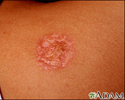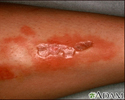Necrobiosis lipoidica diabeticorum
Necrobiosis lipoidica; NLD; Diabetes - necrobiosis
Necrobiosis lipoidica diabeticorum is an uncommon skin condition related to diabetes. It results in reddish brown areas of the skin, most commonly on the lower legs.
Causes
The cause of necrobiosis lipoidica diabeticorum (NLD) is unknown. It is thought to be linked to blood vessel inflammation related to autoimmune factors. This damages proteins in the skin (collagen).
People with type 1 diabetes are more likely to get NLD than those with type 2 diabetes. Women are more affected than men. Smoking increases the risk for NLD. Less than one half of one percent of those with diabetes suffer from this problem.
Symptoms
A skin lesion is an area of skin that is different from the skin around it. With NLD, skin lesions start as firm, smooth, red bumps (papules) on the shins and lower part of the legs. They usually appear in the same areas on opposite sides of the body. They are painless in the early stage.
As the papules become bigger, they flatten. They develop a shiny yellow brown center with raised red to purplish edges. Veins are visible below the yellow part of the lesions. The lesions are irregularly round or oval with well-defined borders. They can spread and join together to give the appearance of a patch.
Lesions can also occur on the forearms. Rarely, they may occur on the stomach, face, scalp, palms, and soles of the feet.
Trauma may cause the lesions to develop ulcers. Nodules also may develop. The area may become very itchy and painful.
NLD is different from ulcers that can occur on the feet or ankles in people with diabetes.
Exams and Tests
Your health care provider can examine your skin to confirm the diagnosis.
If needed, your provider may do a punch biopsy to diagnose the disease. The biopsy removes a sample of tissue from the edge of the lesion.
Your provider may do a glucose tolerance test to see if you have diabetes.
Treatment
NLD can be difficult to treat. Control of blood glucose does not improve symptoms.
Treatment may include:
- Corticosteroid creams
- Injected corticosteroids
- Medicines that suppress the immune system
- Anti-inflammatory medicines
- Medicines that improve blood flow
- Hyperbaric oxygen therapy may be used to increase the amount of oxygen in the blood to promote healing of ulcers
- Phototherapy, a medical procedure in which the skin is carefully exposed to ultraviolet light
- Laser therapy
In severe cases, the lesion may be removed by surgery, followed by moving (grafting) skin from other parts of body to the operated area.
During treatment, monitor your glucose level as instructed. Avoid injury to the area to prevent the lesions from turning into ulcers.
If you develop ulcers, follow steps on how to take care of the ulcers.
If you smoke, you will be advised to quit. Smoking can slow healing of the lesions.
Outlook (Prognosis)
NLD is a long-term disease. Lesions do not heal well and can recur. Ulcers are difficult to treat. The appearance of the skin may take a long time to become normal, even after treatment.
Possible Complications
NLD can rarely result in skin cancer (squamous cell carcinoma).
Those with NLD are at increased risk for:
When to Contact a Medical Professional
Contact your provider if you have diabetes and notice non-healing lesions on your body, especially on the lower part of legs.
References
Fitzpatrick JE, High WA, Kyle WL. Annular and targetoid lesions. In: Fitzpatrick JE, High WA, Kyle WL, eds. Urgent Care Dermatology: Symptom-Based Diagnosis. Philadelphia, PA: Elsevier; 2018:chap 16.
James WD, Elston DM, Treat JR, Rosenbach MA, Neuhaus IM. Errors in metabolism. In: James WD, Elston DM, Treat JR, Rosenbach MA, Neuhaus IM, eds. Andrews' Diseases of the Skin: Clinical Dermatology. 13th ed. Philadelphia, PA: Elsevier; 2020:chap 26.
Patterson JW. The granulomatous reaction pattern. In: Patterson JW, ed. Weedon's Skin Pathology. 5th ed. Philadelphia, PA: Elsevier; 2021:chap 8.
Rosenbach MA, Wanat KA. Non-infectious granulomas. In: Bolognia JL, Schaffer JV, Cerroni L, eds. Dermatology. 5th ed. Philadelphia, PA: Elsevier; 2025:chap 93.
Review Date: 7/21/2024












